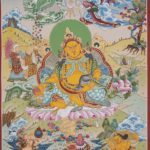About Thangka
Thangka is an art. A thangka is a Tibetan Buddhist painting on cotton, silk applique, usually depicting a Buddhist deity, scene, or mandala. Thangkas are traditionally kept unframed and rolled up when not on display, mounted on a textile backing somewhat in the style of Chinese scroll paintings, with a further silk cover on the front.






























